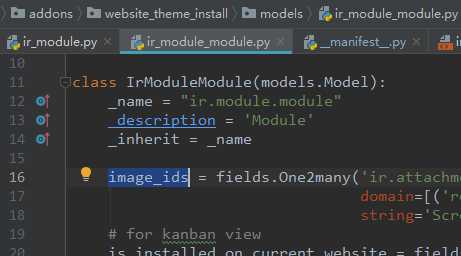odoo研究学习:刷新本地模块列表都干了什么事?
Posted yanhuaqiang
tags:
篇首语:本文由小常识网(cha138.com)小编为大家整理,主要介绍了odoo研究学习:刷新本地模块列表都干了什么事?相关的知识,希望对你有一定的参考价值。

模块信息存储在ir.module.module 数据表中
平时在开发过程中经常会刷新本地模块列表,例如:新增了模块、更新了模块基础信息、更换了模块图标等等,在点击‘更新’按钮的时候odoo平台到底干了哪些事?
后台代码:
# update the list of available packages
@assert_log_admin_access
@api.model
def update_list(self):
res = [0, 0] # [update, add]
default_version = modules.adapt_version(‘1.0‘)
known_mods = self.with_context(lang=None).search([])
known_mods_names = {mod.name: mod for mod in known_mods}
# iterate through detected modules and update/create them in db
for mod_name in modules.get_modules():
mod = known_mods_names.get(mod_name)
terp = self.get_module_info(mod_name)
values = self.get_values_from_terp(terp)
if mod:
updated_values = {}
for key in values:
old = getattr(mod, key)
updated = tools.ustr(values[key]) if isinstance(values[key], pycompat.string_types) else values[key]
if (old or updated) and updated != old:
updated_values[key] = values[key]
if terp.get(‘installable‘, True) and mod.state == ‘uninstallable‘:
updated_values[‘state‘] = ‘uninstalled‘
if parse_version(terp.get(‘version‘, default_version)) > parse_version(mod.latest_version or default_version):
res[0] += 1
if updated_values:
mod.write(updated_values)
else:
mod_path = modules.get_module_path(mod_name)
if not mod_path:
continue
if not terp or not terp.get(‘installable‘, True):
continue
mod = self.create(dict(name=mod_name, state=‘uninstalled‘, **values))
res[1] += 1
mod._update_dependencies(terp.get(‘depends‘, []))
mod._update_exclusions(terp.get(‘excludes‘, []))
mod._update_category(terp.get(‘category‘, ‘Uncategorized‘))
return res
注解1:
@assert_log_admin_access:验证是否为administrator用户,其实就是在验证是否具有管理员权限,跟踪了一下后台调用user._is_admin,如果在验证的时候如果不是administrator权限用户就会跳出异常。
注解2:
@staticmethod
def get_values_from_terp(terp):
return {
‘description‘: terp.get(‘description‘, ‘‘),
‘shortdesc‘: terp.get(‘name‘, ‘‘),
‘author‘: terp.get(‘author‘, ‘Unknown‘),
‘maintainer‘: terp.get(‘maintainer‘, False),
‘contributors‘: ‘, ‘.join(terp.get(‘contributors‘, [])) or False,
‘website‘: terp.get(‘website‘, ‘‘),
‘license‘: terp.get(‘license‘, ‘LGPL-3‘),
‘sequence‘: terp.get(‘sequence‘, 100),
‘application‘: terp.get(‘application‘, False),
‘auto_install‘: terp.get(‘auto_install‘, False),
‘icon‘: terp.get(‘icon‘, False),
‘summary‘: terp.get(‘summary‘, ‘‘),
‘url‘: terp.get(‘url‘) or terp.get(‘live_test_url‘, ‘‘),
‘to_buy‘: False
}
在执行update_list方式中条用get_values_from_terp方法,返回应用信息,判断是否与old信息一致,执行更新write方法。
在icon字段方面,在模型ir.module.module中还有一个icon_image字段,以base64形式存储icon,在icon更新时触发icon_image的更新写入操作:
@api.depends(‘icon‘)
def _get_icon_image(self):
for module in self:
module.icon_image = ‘‘
if module.icon:
path_parts = module.icon.split(‘/‘)
path = modules.get_module_resource(path_parts[1], *path_parts[2:])
else:
path = modules.module.get_module_icon(module.name)
if path:
with tools.file_open(path, ‘rb‘) as image_file:
module.icon_image = base64.b64encode(image_file.read())
以上为当前的理解,但仍有一事不明:
这两个_name = "ir.module.module"什么关系?


以上是关于odoo研究学习:刷新本地模块列表都干了什么事?的主要内容,如果未能解决你的问题,请参考以下文章